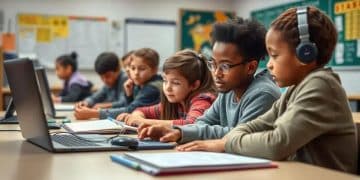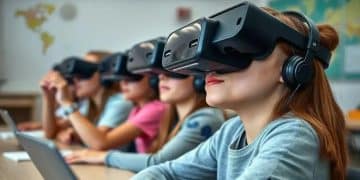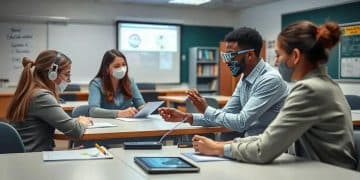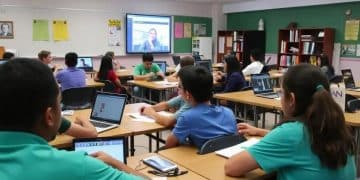Insights on school technology integration for better learning
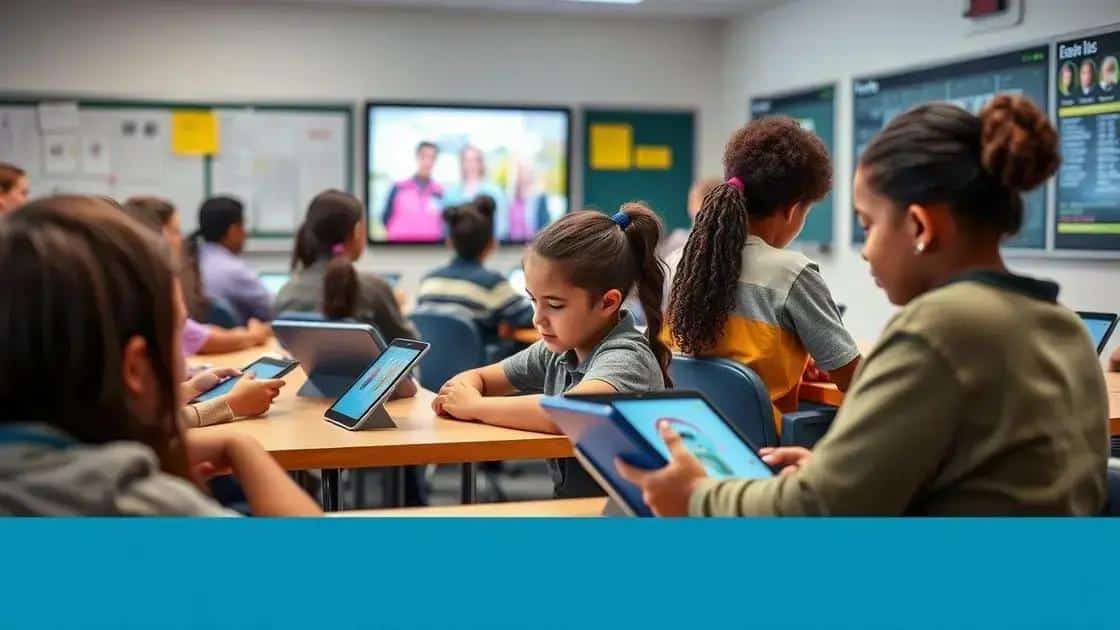
Technology integration in education enhances learning outcomes by measuring impacts, addressing challenges, providing adequate training, and fostering collaboration among educators while promoting a growth mindset among students.
Insights on school technology integration reveal how technology reshapes classrooms, making learning more interactive and engaging. Have you wondered how these advancements can elevate your teaching experience? Let’s dive into the benefits and strategies for effective integration.
The importance of technology in modern education
Technology plays a vital role in modern education. It not only enhances the learning experience but also prepares students for a technology-driven world. As educators, understanding its significance is essential for creating effective learning environments.
Benefits of Technology in Education
Integrating technology brings multiple benefits to schools. It’s crucial to recognize how these advancements support both teachers and students.
- Increased engagement: Interactive tools keep students interested and involved in lessons.
- Access to resources: Technology provides access to a wealth of information and learning materials online.
- Diverse learning methods: Various tools cater to different learning styles, making education more inclusive.
- Collaboration: Students can work together on projects, whether in-person or remotely.
Furthermore, technology offers real-time feedback, which helps students understand their progress and areas for improvement. By utilizing data analytics, teachers can tailor their instructions to meet individual needs.
Preparing Students for the Future
Equipping students with technological skills is critical. As technology evolves, so does the job market. Students must adapt to new tools and skills that employers seek. Schools must integrate technology in a way that reinforces learning, making it a core component of daily activities.
In addition to technical skills, learning to navigate online and digital platforms teaches students about responsibility and safety in the digital world. Understanding the importance of technology helps students cultivate a mindset for lifelong learning, which is essential as they progress in their academic careers.
Through technology, students can develop essential skills such as critical thinking and problem-solving, which are necessary for success in both personal and professional realms. As they engage with different technologies, they also learn adaptability, which is vital in our ever-changing world.
In conclusion, the importance of technology in modern education cannot be overstated. It enriches the learning experience, prepares students for future challenges, and equips them with skills necessary for a competitive workforce.
Best practices for integrating technology in classrooms
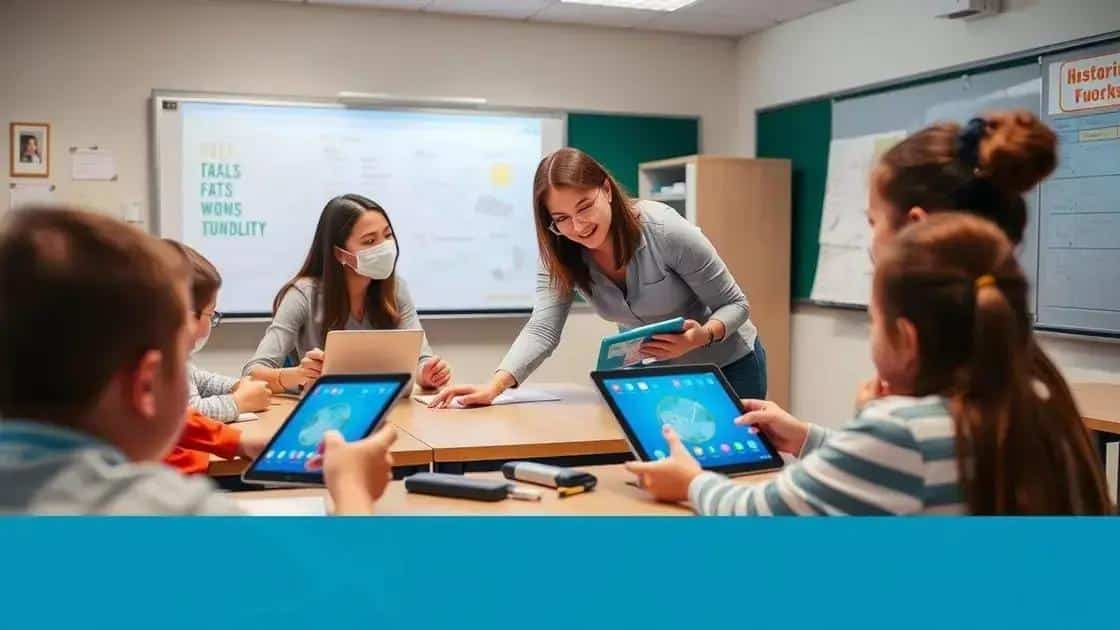
Integrating technology in classrooms effectively can lead to better learning experiences. Understanding and applying best practices ensures that both teachers and students benefit from the advancements that technology offers.
Planning for Integration
A successful integration begins with careful planning. Teachers should assess their classroom needs and identify the tools that best suit their students’ learning styles. Take time to explore various technological tools and their potential impact on learning.
- Identify key objectives: Determine what goals you want to achieve with technology.
- Choose appropriate tools: Select software and hardware that align with your teaching methods.
- Create a supportive environment: Ensure that both students and teachers feel comfortable using the technology.
Moreover, collaboration among staff can enhance the implementation process. Sharing insights and strategies allows educators to learn from each other and improves overall effectiveness.
Training and Support
Providing adequate training for teachers is essential. Familiarizing educators with new technologies empowers them to utilize these tools effectively. Regular professional development sessions can keep staff updated on trends and strategies.
In addition, creating a support system for teachers can foster confidence in using technology. Peer mentoring and access to technical support can make a significant difference in how educators approach digital tools.
Engaging students in the process of integration is also beneficial. Allowing students to explore and experiment with technology cultivates their enthusiasm. When students understand how to use the tools, they are more likely to actively participate in their learning.
As technology becomes more integrated into daily lessons, it’s important to evaluate its effectiveness regularly. Gathering feedback from students and assessing learning outcomes can guide necessary adjustments. This ongoing reflection ensures that technology remains an asset in the classroom.
By applying these best practices, educators can create an environment where technology and teaching work hand in hand to enhance student success.
Evaluating the impact of technology on student learning
Evaluating the impact of technology on student learning is essential to ensure that it enhances education. Understanding how digital tools affect academic performance helps educators make informed decisions about their use in the classroom.
Measuring Learning Outcomes
One effective way to evaluate technology’s impact is through measuring learning outcomes. By comparing test scores, project results, and student feedback before and after technology integration, schools can gather valuable data.
- Collect data on grades: Analyze changes in student grades over a semester.
- Use standard assessments: Implement standardized tests to track learning gains.
- Gather qualitative feedback: Use student surveys to understand their experiences with technology.
Tracking these metrics helps create a clear picture of whether technology is facilitating deeper understanding or engagement among students.
Observing Student Engagement
Another crucial aspect is observing student engagement during lessons. Technology can make learning more interactive and enjoyable, encouraging participation from all students. Teachers should record the level of student involvement, noting which activities capture students’ interests the most.
Engagement can be measured in several ways, including participation in class discussions, completion of assignments, and collaborative projects. Engaged students are more likely to absorb and retain information, making this a vital area to observe.
Regular classroom observations can help identify which technological tools are most effective. If certain platforms foster excitement and curiosity among students, schools should consider expanding their use.
Adjusting Strategies Based on Feedback
Regularly collecting feedback from both students and teachers is also essential. It can provide insights into what is working and what may need adjustment. For instance, if students express challenges with a specific tool, it’s important to address these concerns promptly.
Based on this feedback, schools can refine their integration strategies, ensuring that technology remains a beneficial aspect of the learning process. By making adjustments based on evaluations, educators can optimize the use of technology for maximum impact.
Overall, understanding the impact of technology on student learning through measurements, engagement observations, and feedback can help schools create an enriching educational experience.
Addressing challenges in technology integration

Addressing the challenges in technology integration is crucial for optimizing educational outcomes. Many schools face barriers that can hinder the effective use of technology in classrooms.
Common Challenges
Understanding these challenges helps educators create plans to overcome them. Some common obstacles include insufficient training, lack of resources, and resistance to change.
- Insufficient training: Many teachers feel unprepared to use new technologies effectively.
- Lack of resources: Budget constraints can limit access to necessary tools and support.
- Resistance to change: Some educators may be hesitant to alter traditional teaching methods.
Overcoming these challenges requires proactive measures and a commitment to adapting to new educational landscapes.
Strategies for Overcoming Obstacles
Developing strategies to tackle obstacles is essential for success. Professional development programs can help educators gain confidence with new technologies. Schools should provide regular training sessions that focus on both the practical use of tools and pedagogical strategies.
Building a supportive community can also ease the transition. Encouraging collaboration among teachers fosters an environment where they can share knowledge and experiences. This support system can make integrating technology less intimidating.
Additionally, prioritizing funding for technology initiatives ensures that schools have the necessary resources. Schools can seek grants, partnerships, or community involvement to help enhance their technology offerings. Involving stakeholders can generate ongoing support for technology in the classroom.
Encouraging a Growth Mindset
Lastly, fostering a growth mindset among educators and students is vital. Practicing patience and resilience in the face of challenges promotes a culture of learning. Encouraging experimentation can lead to innovative uses of technology.
Open lines of communication about challenges may also help. When teachers feel comfortable sharing their struggles, it opens opportunities for solutions. By addressing these challenges head-on, schools can enhance the impact of technology in classrooms.
FAQ – Frequently Asked Questions about Technology Integration in Education
What are some common challenges in technology integration?
Common challenges include insufficient training, lack of resources, and resistance to change among educators.
How can schools measure the impact of technology on student learning?
Schools can measure the impact by analyzing learning outcomes such as test scores, student engagement, and qualitative feedback from students.
What strategies can help overcome barriers to technology integration?
Providing adequate training, fostering collaboration among teachers, and creating a supportive environment can help overcome barriers.
Why is fostering a growth mindset important in technology integration?
A growth mindset encourages educators and students to embrace challenges, making them more adaptable to new technologies and teaching methods.

